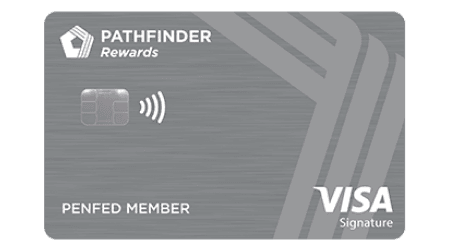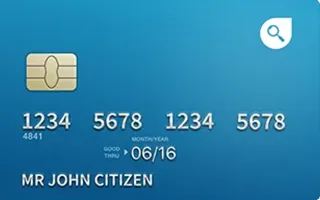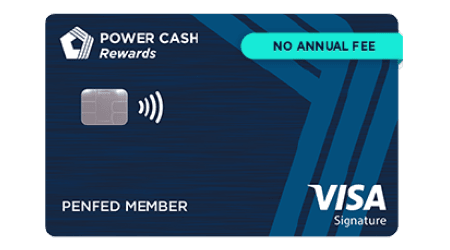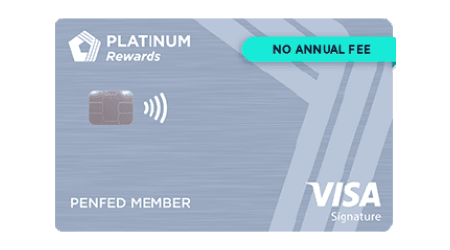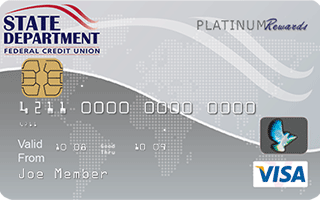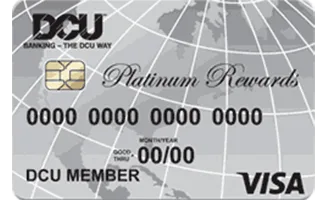Though they’re fewer than the mainline credit cards on the market, credit union credit cards can pack a punch. Finder’s credit card experts reviewed more than 500 credit cards to assess which credit union cards offer the best value within several categories when compared to similar bank offerings, including travel, rewards, cash back and low APR.
Quick look at the best credit union credit cards
Best for travel
PenFed Pathfinder® Rewards Visa Signature® Card
This card isn't just the best travel option among credit unions; it's one of the best travel cards, period. You'll earn strong rewards on travel and generous rewards on all other purchases. You'll also find an $100 annual air travel credit and a $100 credit for your Global Entry/TSA PreCheck application fee — rarities among no-annual-fee cards.
| Welcome Offer | 50,000 points |
|---|
| Rewards | Up to 4x points |
|---|
| Annual fee | $95 |
|---|
| Minimum credit score | 670 |
|---|
-
This card isn't just the best travel option among credit unions; it's one of the best travel cards, period. You'll earn strong rewards on travel and generous rewards on all other purchases. You'll also find an $100 annual air travel credit and a $100 credit for your Global Entry/TSA PreCheck application fee — rarities among no-annual-fee cards.
-
Pros
- Signup bonus. Earn 50,000 bonus points once you spend $3,000 in the first 90 days of card membership. This is worth around $500.
- Reward points. Earn 3x points on all travel purchases — x points if you're a PenFed Honors Advantage Member. All other purchases earn 1.5 points.
- Annual travel credit. Get $100 travel credit each year to cover baggage fees, lounge access, flight changes, pet-kennel fees, phone reservations and in-flight food and beverage purchases.
Cons
- No intro APR for purchases. The PenFed Pathfinder® Rewards Visa Signature® Card doesn’t have an intro APR period on purchases. You’ll start with a standard 17.99% APR.
-
| Annual fee | $95 |
|---|
| Purchase APR | 17.99% variable |
|---|
| Balance transfer APR | 0% intro for the first 12 months (then 17.99% fixed) |
|---|
| Welcome Offer | 50,000 points after spending $3,000 in the first 90 days |
|---|
| Estimated welcome offer value | $500 based on Finder's valuation |
|---|
| Rewards | Up to 4x points |
|---|
| Welcome Offer | 50,000 points |
|---|
| Rewards | Up to 4x points |
|---|
| Annual fee | $95 |
|---|
| Minimum credit score | 670 |
|---|
Best for cashback rewards (high spending)
Alliant Cashback Visa® Signature Credit Card
This card offers the best flat-rate cash back on the market: 2.5% on all purchases. Because it has an annual fee, it's the best choice only if you have a high volume of spending.
| Welcome Offer | n/a |
|---|
| Rewards | Up to 2.5% cash back |
|---|
| Annual fee | $0 |
|---|
| Minimum credit score | 670 |
|---|
-
This card offers the best flat-rate cash back on the market: 2.5% on all purchases. Because it has an annual fee, it's the best choice only if you have a high volume of spending.
-
Pros
- No annual fee.You won't pay an annual fee to use this card.
- Rewards. You’ll earn 2.5% cash back on all purchases on up to $10,000 each billing cycle.
- Relatively low APR. Depending on your credit, you’ll qualify for a purchase and balance transfer APR of 17.24% to 3% variable. These are relatively low rates compared to the average credit card APR of around 16%.
Cons
- Penalty APR. You’ll pay 29.99% variable penalty APR to all of your balances if you make a late or returned payment. This rate applies until you make six consecutive on-time payments of at least the minimum amount due.
- Fees. You’ll pay a 3% fee of the transaction for each balance transfer. For each cash advance, you’ll pay 3% or $10 of the transaction, whichever is greater. For each late or returned payment, you’ll pay a fee of up to $27.
-
| Annual fee | $0 |
|---|
| Purchase APR | From 27.24% fixed |
|---|
| Balance transfer APR | 17.24% to 27.24% fixed |
|---|
| Welcome Offer | N/A |
|---|
| Rewards | Up to 2.5% cash back |
|---|
| Welcome Offer | n/a |
|---|
| Rewards | Up to 2.5% cash back |
|---|
| Annual fee | $0 |
|---|
| Minimum credit score | 670 |
|---|
Best for cashback rewards (low to moderate spending)
PenFed Power Cash Rewards Visa Signature® Card
While the bank-issued PenFed Power Cash Rewards Visa Signature® Card is usually the top choice for flat-rate cash back, PenFed's card is very competitive. It offers 1.5% cash back on all purchases. And if you become a PenFed Honors Advantage member — which you can do by opening a free PenFed Access America Checking Account — you'll earn a top-notch 2% total cash back on all purchases. Crucially, the PenFed Power Cash Rewards Visa Signature® Card has no annual fee, so you can keep all the cash back you earn.
| Welcome Offer | $100 |
|---|
| Rewards | Up to 2% cash back |
|---|
| Annual fee | $0 |
|---|
| Minimum credit score | 670 |
|---|
-
While the bank-issued PenFed Power Cash Rewards Visa Signature® Card is usually the top choice for flat-rate cash back, PenFed's card is very competitive. It offers 1.5% cash back on all purchases. And if you become a PenFed Honors Advantage member — which you can do by opening a free PenFed Access America Checking Account — you'll earn a top-notch 2% total cash back on all purchases. Crucially, the PenFed Power Cash Rewards Visa Signature® Card has no annual fee, so you can keep all the cash back you earn.
-
Pros
- Cash back. Earn 1.5% cash back on all purchases, or % back if you're a PenFed Honors Advantage member. This is in line with similar cashback cards.
- Signup bonus. Earn a $100 statement credit when you spend $1,500 in the first 90 days when you open your account. Other cards that offer 1.5%
- Intro APR on balance transfers. Use 12 months of 0% intro APR period on balance transfers. After the intro APR period ends, your rate reverts to 17.99% variable.
Cons
- No intro APR for purchases. While the PenFed Power Cash Rewards Visa Signature® Card offers an intro APR period on balance transfers, it doesn’t extend to purchases.
-
| Annual fee | $0 |
|---|
| Purchase APR | 17.99% variable |
|---|
| Balance transfer APR | 0% intro for the first 12 months (then 17.99% fixed) |
|---|
| Welcome Offer | $100 after spending $1,500 in the first 90 days |
|---|
| Rewards | Up to 2% cash back |
|---|
| Welcome Offer | $100 |
|---|
| Rewards | Up to 2% cash back |
|---|
| Annual fee | $0 |
|---|
| Minimum credit score | 670 |
|---|
Best for gas and groceries
PenFed Platinum Rewards Visa Signature® Card
PenFed's excellent product offers the highest rewards on gas you can get from a general rewards card. In this space, the credit union comes out on top over the big banks.
| Welcome Offer | $150 points |
|---|
| Rewards | Up to 5x points |
|---|
| Annual fee | $0 |
|---|
| Minimum credit score | 670 |
|---|
-
PenFed's excellent product offers the highest rewards on gas you can get from a general rewards card. In this space, the credit union comes out on top over the big banks.
-
Pros
- Intro APR on balance transfers. Any balance transfers you make — up to a rolling deadline — get a 0% intro APR. After that, a 17.99% variable APR will apply.
- Reward points. Pay at the pump and earn 5x the points, shop at supermarkets for 3x the points and for everything else you'll get 1x the points.
- Signup bonus. Spend $1,500 in the first 90 days you own the card and you'll earn $150 as a statement credit.
Cons
- No intro APR for purchases. There's no intro APR period offered for purchases made on this card. Once you get the card, you'll earn a 17.99% variable APR based on your creditworthiness.
-
| Annual fee | $0 |
|---|
| Purchase APR | 17.99% variable |
|---|
| Balance transfer APR | 0% intro for the first 12 months (then 17.99% fixed) |
|---|
| Welcome Offer | 15,000 Bonus Points when you spend $1,500 in the first 90 days
|
|---|
| Rewards | Up to 5x points |
|---|
| Welcome Offer | $150 points |
|---|
| Rewards | Up to 5x points |
|---|
| Annual fee | $0 |
|---|
| Minimum credit score | 670 |
|---|
Best for rebuilding credit
SDFCU Savings Secured Visa Platinum Card
Rewards are uncommon among secured credit cards, and that's why the SDFCU Savings Secured Visa Platinum Card stands out. You'll earn 1x Flexpoints on all purchases, which you can later redeem for travel, events, merchandise, gift cards, charitable donations and more. You'll also enjoy a relatively low APR on all balances. While it's always a good idea to pay your balance in full each month, a lower interest rate can be helpful in a pinch.
| Welcome Offer | n/a |
|---|
| Rewards | Up to 1x points |
|---|
| Annual fee | $0 |
|---|
| Minimum credit score | 300 |
|---|
-
Rewards are uncommon among secured credit cards, and that's why the SDFCU Savings Secured Visa Platinum Card stands out. You'll earn 1x Flexpoints on all purchases, which you can later redeem for travel, events, merchandise, gift cards, charitable donations and more. You'll also enjoy a relatively low APR on all balances. While it's always a good idea to pay your balance in full each month, a lower interest rate can be helpful in a pinch.
-
Pros
- No annual fee. You don't have to pay annual fee.
- Rewards. 1x Flexpoint for every dollar you spend.
- APR. 17.24% variable APR on all balances.
Cons
- Membership is required. You do have to be a member of the credit union to qualify for the card, even before you apply.
- Your car may be required as collateral. The required documents form mentions that you may be required to provide them power of attorney over your vehicle. Call before you apply to see if this is necessary for your application.
-
| Annual fee | $0 |
|---|
| Purchase APR | 17.24% variable |
|---|
| Balance transfer APR | 17.24% variable |
|---|
| Welcome Offer | N/A |
|---|
| Rewards | Up to 1x points |
|---|
| Welcome Offer | n/a |
|---|
| Rewards | Up to 1x points |
|---|
| Annual fee | $0 |
|---|
| Minimum credit score | 300 |
|---|
Best for no balance transfer fee
DCU Visa® Platinum Rewards Credit Card
While the DCU Visa® Platinum Rewards Credit Card doesn't come with an intro period on balance transfers, it doesn't charge a fee on your balance transfers. Combined with this card's potentially low ongoing APR, you've got a solid card for reducing your interest from other accounts.
| Welcome Offer | n/a |
|---|
| Rewards | Up to 1x points |
|---|
| Annual fee | $0 |
|---|
| Minimum credit score | 630 |
|---|
-
While the DCU Visa® Platinum Rewards Credit Card doesn't come with an intro period on balance transfers, it doesn't charge a fee on your balance transfers. Combined with this card's potentially low ongoing APR, you've got a solid card for reducing your interest from other accounts.
-
Pros
- Reward points. Earn 1x points on all purchases. This isn’t a competitive rewards rate as most similar cards offer 1.5x points.
- No fees. You won’t pay an annual fee, balance transfer fee, foreign transaction fee or cash advance fee.
- Potentially low APR. The APR you get depends on your creditworthiness and can start from 16% variable. Other cards can have up to 28% APR.
Cons
- No signup bonus. You won’t be able to earn a signup bonus with this card.
- No intro APR period The card comes with potentially low APR, but that can’t beat a 0% intro APR credit cards when looking to save money on interest payments.
-
| Annual fee | $0 |
|---|
| Purchase APR | 16% variable |
|---|
| Balance transfer APR | 16% variable |
|---|
| Welcome Offer | N/A |
|---|
| Rewards | Up to 1x points |
|---|
| Welcome Offer | n/a |
|---|
| Rewards | Up to 1x points |
|---|
| Annual fee | $0 |
|---|
| Minimum credit score | 630 |
|---|
Choosing a credit union credit card comes down to many of the same factors you would consider with a standard credit card, albeit with a few additional items to note. Here’s how to choose the best one for your needs.
- Examine your nearby options. It can help to visit a credit union in person when setting up an account. If you don’t have a particular union nearby, you might want to look at your other options.
- Review your financial needs. Many credit unions offer the card categories you’d expect of a bank. However, your available options within each category may prove more limited than the bigger name issuers out there.
- Do you want to perform a balance transfer? Some credit union credit cards don’t offer balance transfers. The cards that do provide this service are less likely to have a 0% interest rate during the introductory period when compared to cards from banks. However, credit union credit cards usually have a lower ongoing interest rate than typical credit cards.
- Where do you spend most? Credit unions often feature fewer bonus categories or lower rewards rates on their credit cards than banks.
- Look at that card’s additional perks and features. In general, you’ll find fewer complimentary extras from a credit union credit card compared to the major banks.
These cards are issued by credit unions instead of banks. They tend to have lower fees and interest rates than cards issued by larger financial institutions.
To get a credit union credit card, you need to become a member of the credit union, which usually involves a fee of around $5 to $25. You may also need to open a savings account before or during your application.
How can you apply for a credit union credit card without being a member?
Typically, you can apply for a credit union credit card even if you’re not a member. But if you’re approved, you’ll need to sign up to become a member to receive the card.
You’ll find different eligibility criteria for membership in credit unions. For example, you may need to work under a certain employer, live in a certain area, be a family member of a current member or have a certain occupation. Some credit unions let anyone become a member as long as they join certain nonprofit organizations.
To join a credit union, you may need to pay a small fee of $10 or less.
What is a credit union?
A credit union is a financial institution that’s owned by its members. It’s a nonprofit, serving its members rather than seeking to generate profit for shareholders. This is why you’ll often find higher savings when using a credit union.
Once you’re a member, you’ll also have the opportunity to influence how the credit union is run. For example, you may be able to vote at annual general meetings or provide feedback that influences the features of different products.
Benefits and disadvantages of credit union credit cards
Like with any financial tool, there are pros and cons to credit union credit cards.
Benefits
- Competitive ongoing interest rates.
- Lower annual fees.
- Same annual percentage rate for purchases and cash advances.
- Personalized service.
Disadvantages
- You have to meet membership eligibility requirements.
- Limited reward options.
- Limited balance transfer options.
- Less competitive introductory APR offers.
Join a credit union for a unique community
Besides benefits such as lower interest rates, consumers often flock to credit unions for additional reasons, including:
- Community.
As well as being focused on benefiting members, credit unions usually have a community focus. For example, they may provide funding for local groups and schools and encourage arts and performance to strengthen bonds. - Limited membership.
Some credit unions also limit membership to people in specific industries. For example, Teachers Mutual Bank primarily offers membership to retired and current teachers, university students studying to become teachers and other employees in the education sector. - Banking differently.
As a result of these credit union features, people often pay as much attention to a credit union’s philosophy as they do to specific products and features. This level of involvement means credit unions often suit people who want to completely change the way they bank. - Special rewards.
Credit unions may bump up credit card rewards exclusively for members and those with certain accounts. With the PenFed Pathfinder® Rewards Visa Signature® Card, for example, you’ll earn 4x points on travel purchases if you’re a PenFed Honors Advantage member. Most other cardholders earn 3x points on travel.
Whether you go with a credit union or bank for your credit needs ultimately depends on your financial situation. Compare the options to determine which is right for you.
| Focus | Provides better member experiences and improves members’ financial situations with quality products and suitable advice. | Maximize profits for their shareholders, so they can attract more investors. |
| Profit | Goes back into the system to provide its members with competitive rates and offerings. | Goes to its shareholders. The bank might invest some of it in different kinds of financial products. |
| Security | Credit unions offer Mastercard and Visa credit cards, both of which provide secure payment systems and protection against fraudulent electronic transactions. | Banks offer the same security measures. |
| Rewards | Credit unions provide credit cards linked to a limited amount of major rewards programs. | Banks offer a range of rewards credit cards as well. |
| Other benefits | As a member, you have a say on how the credit union is run. | Banks also offer added features through their credit cards, but you might have to pay higher annual fees in this case. |
Want a better idea of what credit union cards are available to you? Select up to four cards and choose Show cards to start comparing them side by side.
How the Finder Score helps you find a better credit card
The Finder Score is a simple score out of 10. The higher a savings account's score, the better we think it is for the average customer.
We score each credit card in our database of hundreds based on a data-driven methodology with 3 main criteria: Does the card offer rewards? Does the card have an annual fee? What's the card APR%?
Credit union credit cards can prove just as valuable as credit cards from major banks. Whether one is the right choice, however, depends on your financial needs and values. For more options, check out our guide to the best credit cards of 2022.
